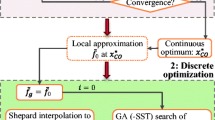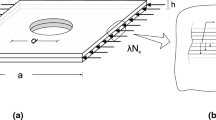Abstract
Designers and engineers are constantly seeking for more efficient structures that can achieve a high performance with minimum weight. Since its inception, topology optimization has been evolving and new features and methods have been proposed to support the development of such lightweight and high-performance structures. In recent years, the application of multiple-material topology optimization in the conceptual design as well as the consideration of composite materials in the topology optimization process has increased. Composite materials usually offer a superior stiffness-to-weight ratio compared to isotropic materials, but it also requires engineers to define the lamination layup. The lamination stacking sequence can also be optimized through different methods, nevertheless the combination of stacking sequence and topology optimization is still limited in the literature. Therefore, the present paper presents a method to simultaneously optimize the material placement, selection and stacking sequence of composite plates in a multi-material topology optimization framework. The methodology considers that the macro-mechanical composite material response is governed by the orientation of the layers and the composite material properties. As a result, the optimum material placement and selection depend on the material layup that is defined along with the optimization process. A series of example problems are presented and discussed to demonstrate the proposed algorithm capabilities.












Similar content being viewed by others
References
Albazzan MA, Harik R, Tatting BF, Gürdal Z (2019) Efficient design optimization of nonconventional laminated composites using lamination parameters: a state of the art. Compos Struct 209:362–374. https://doi.org/10.1016/j.compstruct.2018.10.095
Allaire G, Delgado G (2016) Stacking sequence and shape optimization of laminated composite plates via a level-set method. J Mech Phys Solids 97:168–196. https://doi.org/10.1016/j.jmps.2016.06.014
Altair. (2019). Altair OptiStruct 2019 User Guide. Troy, Michigan. https://connect.altair.com/CP/downloads.html.
Bendsøe MP, Kikuchi N (1988) Generating optimal topologies in structural design using a homogenization method. Comput Methods Appl Mech Eng 71:197–224
Blasques JP (2014) Multi-material topology optimization of laminated composite beams with eigenfrequency constraints. Compos Struct 111:45–55. https://doi.org/10.1016/j.compstruct.2013.12.021
Bohrer R, Kim IY (2021a) Multi-material topology optimization considering isotropic and anisotropic materials combination. Struct Multidiscip Optim 64(3):1567–1583. https://doi.org/10.1007/s00158-021-02941-z
Bohrer RZG, Kim IY (2021b) Concurrent topology and stacking sequence optimization of composite laminate plates using lamination parameters. Compos Struct. https://doi.org/10.1016/j.compstruct.2021.114556
Fukunaga H, Sekine H (1992) Stiffness design method of symmetric laminates using lamination parameters. AIAA J 30(11):2791–2793. https://doi.org/10.2514/3.11304
Ghiasi H, Pasini D, Lessard L (2009) Optimum stacking sequence design of composite materials part I: constant stiffness design. Compos Struct 90(1):1–11. https://doi.org/10.1016/j.compstruct.2009.01.006
Gibiansky LV, Sigmund O (1999) (2000) Multiphase composites with extremal bulk modulus. J Mech Phys Solids 48:461–498. https://doi.org/10.1016/s0022-5096(99)00043-5
Li C, Kim IY (2017) Multi-material topology optimization for automotive design problems. Proc Inst Mech Eng Part D 232(14):1950–1969. https://doi.org/10.1177/0954407017737901
Li D, Kim IY (2018) Multi-material topology optimization for practical lightweight design. Struct Multidiscip Optim 58(3):1081–1094. https://doi.org/10.1007/s00158-018-1953-z
Li D, Kim IY (2019) Modified element stacking method for multi-material topology optimization with anisotropic materials. Struct Multidiscip Optim 61(2):525–541. https://doi.org/10.1007/s00158-019-02372-x
Lund E (2009) Buckling topology optimization of laminated multi-material composite shell structures. Compos Struct 91(2):158–167. https://doi.org/10.1016/j.compstruct.2009.04.046
Lund E, Stegmann J (2005) On structural optimization of composite shell structures using a discrete constitutive parametrization. Wind Energy 8(1):109–124. https://doi.org/10.1002/we.132
Peeters D, van Baalen D, Abdallah M (2015) Combining topology and lamination parameter optimisation. Struct Multidiscip Optim 52(1):105–120. https://doi.org/10.1007/s00158-014-1223-7
Ryan L, Kim IY (2019) A multiobjective topology optimization approach for cost and time minimization in additive manufacturing. Int J Numer Meth Eng 118(7):371–394. https://doi.org/10.1002/nme.6017
Sabiston G, Kim IY (2019) 3D topology optimization for cost and time minimization in additive manufacturing. Struct Multidiscip Optim 61(2):731–748. https://doi.org/10.1007/s00158-019-02392-7
Sanders ED, Pereira A, Aguiló MA, Paulino GH (2018) PolyMat: an efficient Matlab code for multi-material topology optimization. Struct Multidiscip Optim 58(6):2727–2759. https://doi.org/10.1007/s00158-018-2094-0
Shiye B, Jiejiang Z (2016) Topology optimization design of 3D continuum structure with reserved hole based on variable density method. J Eng Sci Technol Rev 9(2):121–128. https://doi.org/10.25103/jestr.092.20
Sigmund O, Petersson J (1998) Numerical instabilities in topology optimization: a survey on procedures dealing with checkerboards, mesh-dependencies and local minima. Struct Optim 16:68–78
Sigmund O, Torquato S (1997) Design of materials with extreme thermal expansion using a three phase topology optimization method. J Mech Phys Solids 45(6):1037–1067. https://doi.org/10.1016/S0022-5096(96)00114-7
Stegmann J, Lund E (2005) Discrete material optimization of general composite shell structures. Int J Numer Meth Eng 62(14):2009–2027. https://doi.org/10.1002/nme.1259
Svanberg K (1987) The method of moving asymptotes—a new method for structural optimization. Int J Numer Meth Eng 24:359–373
Thomsen J (1992) Topology optimization of structures composed of one or two. Struct Optim 5:108–115
Tong X, Ge W, Gao X, Li Y (2019) Simultaneous optimization of fiber orientations and topology shape for composites compliant leading edge. J Reinf Plast Compos 38(15):706–716. https://doi.org/10.1177/0731684419842292
Tong X, Ge W, Zhang W (2015) Optimal fiber orientations and topology of compliant mechanisms using lamination parameters. Paper presented at the International Conference on Advanced Mechatronic Systems, Beijing, China.
Tsai SW, Pagano NJ (1968) Invariant properties of composit materials. St Louis, Missouri
Werthen E (2016) Design rules consideration within optimization of composite structures using lamination parameters (Master Master Thesis). University of applied sciences of Landshut and Ingolstadt, Germany. (DLR-IB-FA-BS-2016-173)
Funding
This research was funded by the Natural Sciences and Engineering Research Council of Canada (NSERC).
Author information
Authors and Affiliations
Corresponding author
Ethics declarations
Conflict of interest
The authors declare that they have no conflict of interest.
Replication of results
Sufficient information for replicating results is provided throughout the manuscript A pseudocode is also provided in the Appendix to assist with the replication of the results presented in this paper.
Additional information
Responsible Editor: Seonho Cho
Publisher's Note
Springer Nature remains neutral with regard to jurisdictional claims in published maps and institutional affiliations.
Appendix: Pseudocode
Appendix: Pseudocode
! MMTO-SS method.
PROGRAM MAIN
! This function imports all user parameters.
CALL SUBROUTINE IMPORT_USER_PARAMETERS
! Initialize design variables and optimization parameters.
CALL SUBROUTINE INITIALIZE
! Main optimization loop.
DO I = 1, MAXITER.
! Update material properties.
! uses SIMP equation to define the interpolated material tensors.
CALL SUBROUTINE UPDATE_MATERIAL_PROPERTIES
! Run FEA.
CALL SUBROUTINE RUN_FEA
! Compute Objective Function and its Sensitivities.
CALL SUBROUTINE OBJECTIVE_FUNCTION_SENSITIVITIES
! Checkboard filter.
CALL SUBROUTINE CHECKBOARD_FILTER
! Compute Constraint and Sensitivities.
CALL SUBROUTINE CONSTRAINT_FUNCTION_SENSITIVITIES
! MMA design variable update.
CALL SUBROUTINE MMA_DESIGN_VARIABLE_UPDATE
! Write results to ASCII files for users.
CALL SUBROUTINE WRITE_RESULTS
! Set updated design variables from MMA.
CALL SUBROUTINE SET_DESIGN_VARIABLES
! Check for convergence.
CALL SUBROUTINE CONVERGENCE_CHECK
! Exit if convergence is met.
IF(CONVERGENCE_TOLERANCE < = USERDEFINEDVALUE) EXIT.
! Finish Optimization CPU time.
CALL CPU_TIME (FINISH)
ENDDO
END PROGRAM MAIN
! MMTO-SS method – Ply angle retrieval process.
PROGRAM PLY_ANGLE_RETRIEVAL
! This function imports all user parameters – number of layers, optimum set of LPs.
CALL SUBROUTINE IMPORT_USER_PARAMETERS
! This subroutine computes the LPs for each ply orientation and defines its distance from the optimum set of LPs.
CALL SUBROUTINE DATABASE
! This subroutine sorts the LPs candidates.
CALL SUBROUTINE SORT_LPs.
! Write results to ASCII files for users.
CALL SUBROUTINE WRITE_RESULTS
END PROGRAM PLY_ANGLE_RETRIEVAL
Rights and permissions
Springer Nature or its licensor holds exclusive rights to this article under a publishing agreement with the author(s) or other rightsholder(s); author self-archiving of the accepted manuscript version of this article is solely governed by the terms of such publishing agreement and applicable law.
About this article
Cite this article
Bohrer, R.Z.G., Kim, I.Y. Multi material topology and stacking sequence optimization of composite laminated plates. Struct Multidisc Optim 65, 274 (2022). https://doi.org/10.1007/s00158-022-03363-1
Received:
Revised:
Accepted:
Published:
DOI: https://doi.org/10.1007/s00158-022-03363-1




